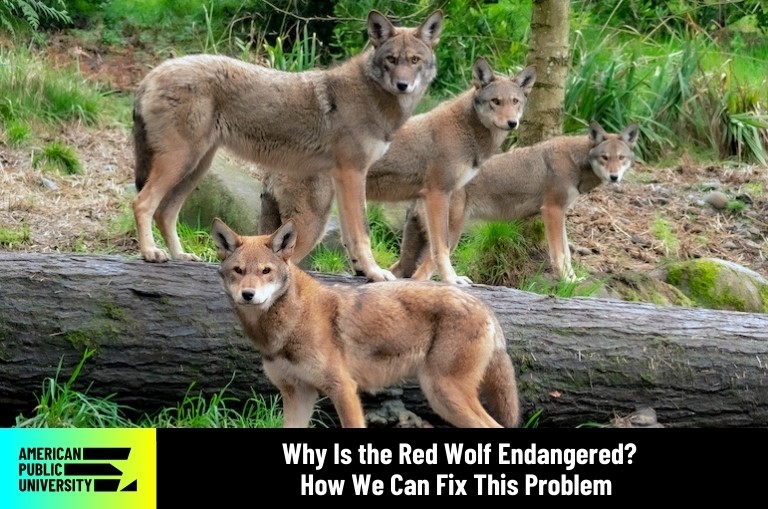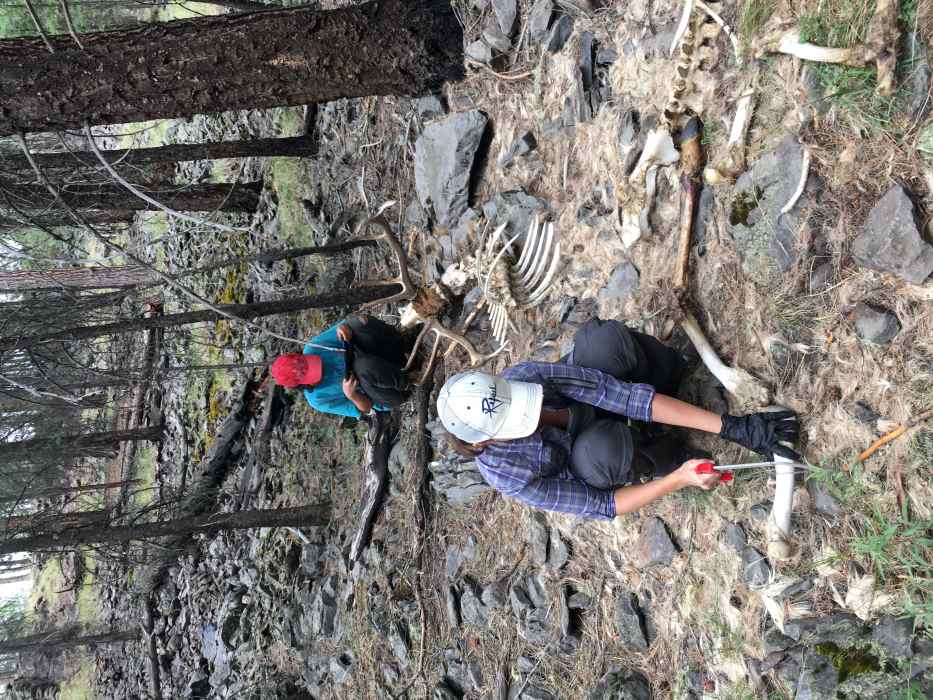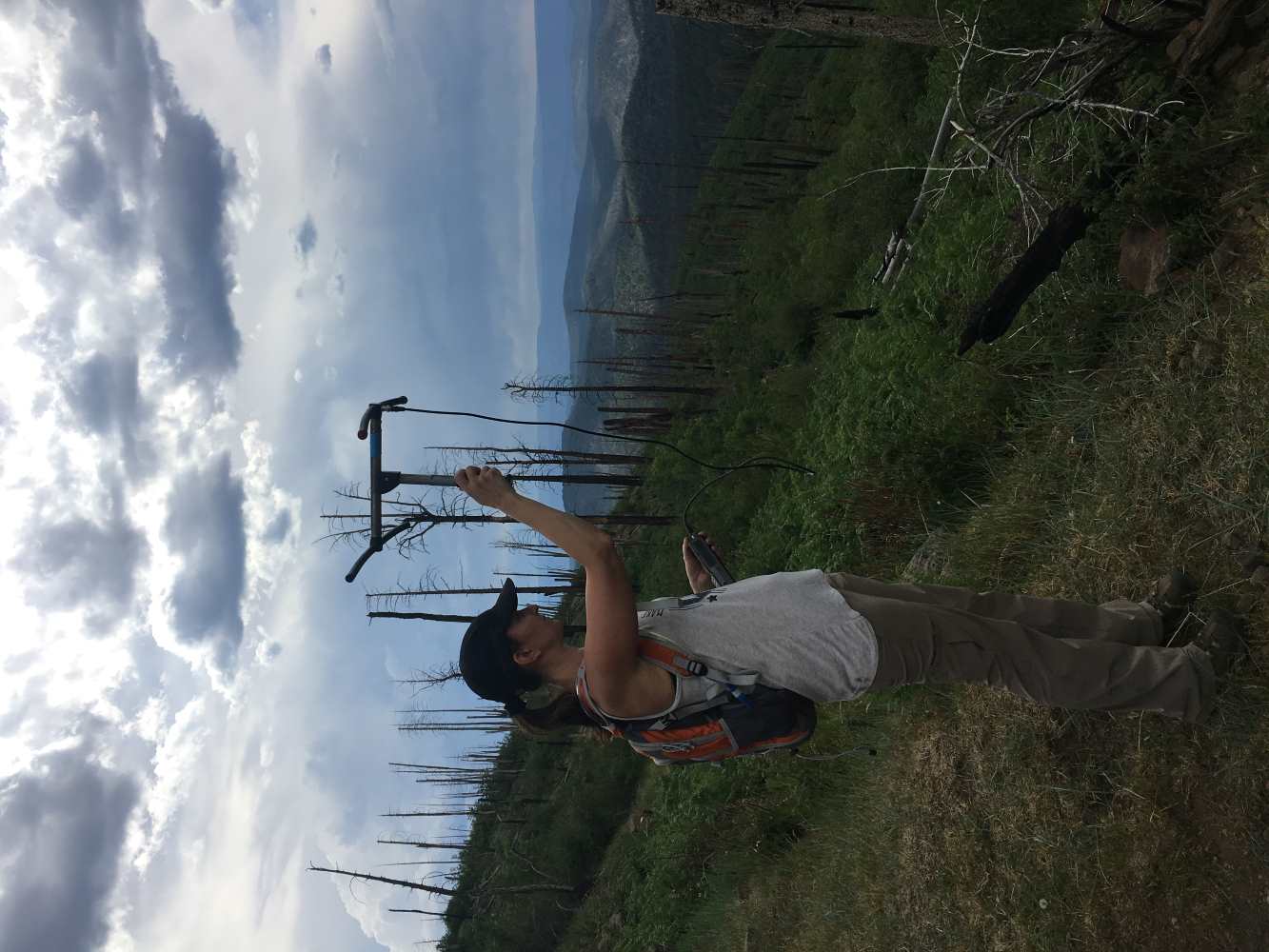By Dr. Suzanne Agan | 01/12/2024

Throughout the 1900s, the red wolf population experienced a drastic decline, enough to place red wolves on the endangered list. But with modern-day conservation, why is the red wolf endangered now?
How Did the Red Wolf End Up on the Endangered Species List?
Red wolves used to roam the southeastern United States as far south as Texas and Louisiana and as far north to New York. Over time, though, humans have almost eliminated these predators. Wolf bounties were first awarded in North Carolina in the late 1700s, and wild red wolves were completely absent east of the Mississippi by 1944.
Red wolves, like all wolves, were viewed as a threat to both livestock and big game so they were killed through government-sponsored, intensive predator control programs that resulted in the near extinction of the species. In fact, red wolves were wiped out in all but a very small portion of their range in Texas and Louisiana.
Government Efforts to Save the Red Wolf Population
It wasn’t until 1962 that concerns were raised about the potential loss of the entire species. In 1966, red wolves were listed as an endangered species under the Endangered Species Preservation Act.
In 1969, the government took positive action, starting a captive breeding program to save red wolves. Additional protection for red wolves was created by the 1973 Endangered Species Act, according to the U.S. Department of the Interior.
Between 1974 and 1980, 400 wolves were captured for the captive breeding program and the U.S. Fish and Wildlife Service declared red wolves extinct in the wild. Fourteen of those red wolves would become the genetic future of all wild red wolves.
It's a tricky decision to capture the last known remaining wild animals for any species, because then all hope for recovery is placed on the captive breeding program. Considerations include important questions such as:
- Will they breed in captivity?
- Will they then be too tame to release again in the future?
Endangered red wolves became a field experiment in the reintroduction of a large carnivore, the first recovery effort of its kind. Understanding the need to keep red wolves wild and preserve their instinct to generally avoid humans, conservation centers raised red wolves in isolation so that they retained their natural instincts of human avoidance.
How Red Wolves Are Raised in Captivity and Released into the Wild
In a red wolf recovery program, individuals raised in captivity for the purpose of reintroduction are kept out of sight of humans. Biologists reintroducing red wolves to a wild habitat use a “soft release,” which helps the red wolves to adjust more easily.
Though they have been raised away from human influence, they are still not acclimated to the wild locations where they will live. To increase their chances of success, adult red wolves are placed in an acclimation pen with temporary fencing and fed native prey, while they get used to their environment. This tactic also gives them time to form pair bonds with a potential mate placed in the same pen.
Because the pair of adult red wolves start out as breeding wolves, they have a higher chance of success in raising a litter and forming a stable pack. As the numbers of wild red wolves are so few, the chances of a red wolf finding a suitable mate would otherwise be extremely low.
The Benefits of a Thriving Red Wolf Population
In 1987, four breeding adult pairs of red wolves were released into the wild in northeastern North Carolina on Alligator River National Wildlife Refuge (ARNWR). It was the perfect place for breeding pairs of red wolves: no coyotes as competition, a low number of livestock, lots of farmland, and protected areas with plenty of prey species such as white-tailed deer.
Red wolves were often seen sitting in crop fields during the day. Their presence could potentially be considered a blessing to farmers since they kept deer and other animals away from valuable crops.
In the years since red wolves were reintroduced, coyotes migrated the rest of the way across the United States and finally into North Carolina, filling the niche of top predator where wolves had been eliminated and red wolves had yet to expand. However, in high enough numbers, red wolves will defend territory and exclude coyotes, providing another valuable service to humans.
Unfortunately, the wild populations' success would not hold. Over the next 34 years, the red wolf population would see a lot of change.
Ultimately, humans would once again cause the red wolf species to move nearer to extinction, mostly through poaching and vehicle strikes. By 2021, there were less than 10 red wolves known to remain in the wild.
Ongoing Efforts Are in Place to Save Endangered Red Wolves
Red wolves are considered a “nonessential experimental population,” which gives the Fish and Wildlife Service more flexibility in their management and allowing this government agency to work with private landowners. For conservation biologists, it has been an exciting time to see the reintroduction of an almost-eliminated, endangered wolf species whose demise was at the hands of humanity.
The captive breeding program, known as a Species Survival Plan (SSP), raises individual wolves and family groups to maintain genetic diversity and the future of the wild red wolf population. As of October 2023, there are approximately 267 red wolves in 50 Red Wolf Saving Animals From Extinction (SAFE) facilities across the country, according to the U.S. Fish and Wildlife Service.
From this program, biologists have conducted a brave, unique, and highly successful program of introducing young, captive-born pups into an existing wild litter. Known as pup fostering, breeding adult pairs of red wolves have accepted the new wolf pups as part of their own litters.
In 2022, the first red wolves were born in the wild since the last known litter in 2018. New releases are taking place, and there are now an estimated 21-23 (11 known) red wolves in the wild.
The red wolf recovery program has another chance at success through the diligence of the Red Wolf Recovery Team. In September, we published the new Red Wolf Recovery Plan for not only North Carolina but also other future reintroduction sites when they are chosen and established.
There will need to be intense cooperation between the U.S. Fish and Wildlife Service, state and local agencies, and private landowners for red wolves to not only survive but flourish. I am hopeful that we have learned our lessons from the past as we move forward to bring back red wolves from the brink of extinction. For now, they remain the most critically endangered canid in the world.

Mexican wolf kill investigation. Image courtesy of author.
Other Types of Wildlife Are Also Endangered Species Besides Red Wolves
Red wolves are but one small picture of a much larger issue. Why are species becoming endangered, what can we do about it, and should we do anything?
The International Union for the Conservation of Nature has a list of more than 157,100 species and more than 44,000 of those species are threatened with extinction. The percentage of endangered species includes:
- 41% of amphibians
- 37% of sharks and rays
- 36% of reef-building corals
- 34% of conifers
- 26% of mammals
- 12% of birds
Although legislation such as the Endangered Species Act has been useful, there is still much more work to be done.

Using an antenna to track the location of Mexican wolves. Image courtesy of author.
Why Should We Care about an Endangered Species Becoming Extinct?
The process of species becoming extinct is a natural one. The baseline extinction rate is about one species per every one million species per year, according to the Smithsonian’s National Museum of Natural History.
However, today is different because endangered populations are disappearing at a greater rate than ever before. Scientists agree that today’s extinction rate is hundreds, or even thousands, of times higher than the natural baseline extinction rate.
So what? Some people – including myself – believe that species have a right to live and die without human interference. Also, each species plays an essential role in the proper functioning of our ecosystems. We depend on these ecosystems for food, water purification, waste treatment, and medication among many other ecosystem services.
All species, including endangered species, have roles in our ecosystem that we will never fully understand. It’s only once they are completely gone that we learn the full ramifications of the loss.
Red wolves (along with other wild wolf populations) are considered a keystone species. They are critical for the proper functioning of an ecosystem, using top-down mechanisms known as trophic cascades. Trophic cascades occur when predators limit the density and behavior of their prey, which enhances the survival of other species further down on the food chain.
In the absence of a keystone species, an ecosystem will usually experience a collapse. When top predators disappear, the numbers of prey species increase, and important vegetation is overgrazed and eliminated. Barren areas appear and the survival of the entire ecosystem is at risk if no action is taken.
We have learned in recent years that while climate is the main driver of the type of vegetation in a biome, ecosystem regulation by species such as wolves may be a more potent driver than historically recognized.
So yes, we absolutely should do something to conserve the population of red wolves and decrease the possibility of their extinction. How conservation efforts will be implemented depends upon each type of species and its location. For instance, lessons from the red wolf recovery program have been a model for the introduction of other endangered species such as gray wolves and Mexican gray wolves across the United States.
Fortunately, there are scientists all over the world who have been working together to create comprehensive plans for other endangered species. My small part has been to play a role in the future of the red wolf.
Red wolves are playful and fiercely devoted to family, which is what drew me to this research in the first place. It is my hope that their howls will still be heard by my grandchildren and their grandchildren. The silence that would exist without red wolves would otherwise be deafening.
Aldo Leopold, known as one of the founders of the modern conservation movement and former professor at the University of Wisconsin, was a wolf hunter until he realized what killing the wolves had done. In his essay “Thinking Like a Mountain,” he said, “I have lived to see state after state extirpate its wolves. I have watched the face of many a newly wolfless mountain and seen the south-facing slopes wrinkle with a maze of new deer trails.
“I have seen every edible bush and seedling browsed, first to anemic desuetude, and then to death. I have seen every edible tree defoliated to the height of a saddle horn. Such a mountain looks as if someone had given God a new pruning shears and forbidden Him all other exercise. In the end the starved bones of the hoped-for deer herd, dead of its own too-much, bleach with the bones of the dead sage, or molder under the high-lined junipers.
“I now suspect that just as a deer herd lives in mortal fear of its wolves, so does a mountain live in mortal fear of its deer. And perhaps with better cause, for a while a buck pulled down by wolves can be replaced in two or three years, a range pulled down by too many deer may fail of replacement in as many decades.
“Perhaps this is behind Thoreau’s dictum: In wildness is the salvation of the world. Perhaps this is the hidden meaning of the howl of the wolf, long known among mountains, but seldom perceived among men.”
So does the red wolf continue to be endangered? Yes, but steps are being taken to bring it back from complete extinction before it’s too late. I am hopeful those steps will be successful.
Dr. Suzanne Agan is an instructor in the School of Science, Technology, Engineering and Math. She holds a B.S. in Biology from the University of North Carolina at Greensboro, a M.S. in Wildlife Science from Texas A&M University, a M.S. in Interdisciplinary Environmental Studies from Antioch University, and a Ph.D. in Environmental Science from Antioch University New England.
Suzanne has been an educator in wildlife, conservation, and environmental sciences for almost 20 years after working in the field as a wildlife biologist. Her interdisciplinary Ph.D. research focused on spatial, ecological, and human dimension aspects of red wolf survival. She currently serves on the USFWS Red Wolf Recovery Team and is co-chair of the APU/AMU Student Chapter of the Wildlife Society. In addition, Suzanne is a faculty advisor for the University’s chapters of Women in STEM (wSTEM) and the Association of Women in Science (AWIS).

